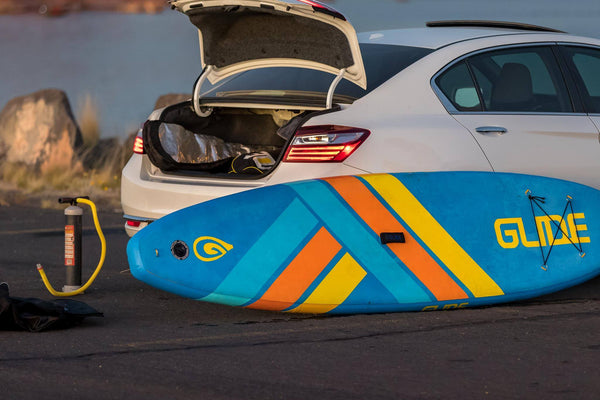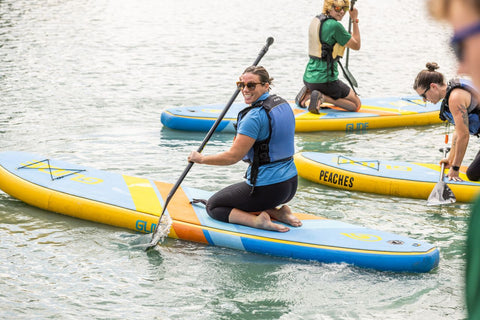
How to Inflate Your New Glide Inflatable Board
We understand that getting a new paddle board can be nerve-racking during the set up. We suggest you practice a few times in your home before you take it out. Watch our video and follow along!
Key Highlights
- Prepare the Area: Start by finding a clean, flat surface near water, free of sharp objects, to unroll your board.
- Valve Check: Ensure the valve is in the closed position to prevent air escape during inflation.
- Pump Attachment: Securely attach the pump to your board's valve, whether using a manual or electric pump.
- Inflating to the Right PSI: Inflate your board to the recommended PSI, typically between 12-15 PSI, for optimal performance.
- Pressure Check: Frequently check the pressure as you near the full inflation to avoid over or under-inflation.
- Fin Installation: After inflation, attach any detachable fins to aid in the board's stability and maneuverability.
- Safety Inspection: Conduct a final inspection of the board, valve, and fins to ensure everything is secure before getting on the water.
- Safety Gear: Always wear a personal flotation device (PFD) for safety while paddle boarding.
Getting out onto the water with your new Glide 02 Inflatable paddle boards is quick and easy. The embedded video will go over all the steps to get you out on the water as fast as possible.
1. Unpack and Unroll
First, find a clean, flat surface near the water to unpack and unroll your glide paddle board. Ensure the area is free of sharp objects or debris that could damage the board. Unroll the board with the fins facing up to access the valve easily.
2. Check the Valve
Before inflating, it's essential to check the valve to ensure it's in the closed position. The valve is typically a spring-loaded mechanism; you'll press down and twist to lock it in the closed position, preventing air from escaping once you start inflating.
3. Attach the Pump
Connect the pump to the valve. Most glide paddle boards come with a manual or electric pump. Ensure the connection is secure to avoid air leakage. If you're using a manual pump, attach the hose to both the pump and the board's valve. For electric pumps, follow the manufacturer's instructions for connection.
4. Start Inflating
Begin to inflate the board. If you're using a manual pump, use consistent, full pumps to fill the board. Electric pump users should set the desired PSI (pounds per square inch) level—typically around 12-15 PSI for most boards—and let the pump do the work. Keep an eye on the pressure gauge to avoid over-inflation.
5. Check the Pressure
As you approach the recommended PSI, check the pressure frequently. Over or under-inflation can affect the board's performance and longevity. Most glide paddle boards perform best between 12-15 PSI, providing the right balance of rigidity and flexibility.
6. Remove the Pump and Close the Valve
Once you've reached the desired PSI, carefully disconnect the pump from the valve. Quickly close the valve by pressing down and twisting it to the locked position, ensuring no air escapes.
7. Attach the Fin(s)
If your board has detachable fins, now is the time to attach them. Ensure they are securely fastened according to the manufacturer's instructions, as they play a crucial role in the board's stability and maneuverability.
8. Perform a Final Inspection
Before heading into the water, perform a final inspection of the board, valve, and fins to ensure everything is secure and there are no leaks.
9. Safety Check
As a safety precaution, always wear a personal flotation device (PFD) when using your paddle board, regardless of your swimming abilities.
10. Enjoy Your Paddle Board

With your board now fully inflated and inspected, you're ready to hit the water. Enjoy the experience, and always follow local water safety regulations and practices.
Inflating your Glide paddle board properly is key to a great experience on the water. By following these steps, you can ensure your board is safe, durable, and performs at its best. Remember to take care of your board by deflating it correctly and cleaning it after use to maintain its condition for years to come.
Related Topics
Learn to Inflate and Deflate an Inflatable SUP


